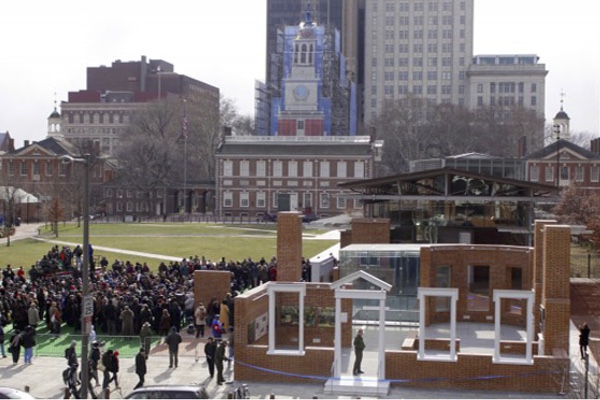The Memorial Where Slavery Is Real

Related Links
● A Georgia County Where the Rebel Flag Is Still Revered
● Flag Opponents Turn Eyes to South Carolina House
There are countless memorials and museums dedicated to our slave-owning founders, but 150 years after the Civil War, there still exists no federally funded museum dedicated solely to the memory of African-American slaves and the system under which they toiled. The mystery of the missing museums, while noted for years, has been revived again by the recent Confederate flag debate. As Columbia historian Eric Foner recently told the New York Times Magazine, “If the Germans built a museum dedicated to American slavery before one about their own Holocaust, you’d think they were trying to hide something.”
There may, however, be a close contender, if only a meager one, for the first federally funded slave memorial: Tucked in a corner of Independence Mall in Philadelphia—home to the Liberty Bell, Independence Hall and nearby Constitution Center—lies what its creators say is the country’s only congressionally funded memorial on federal property to explicitly honor some of America’s early slaves. Specifically, it pays tribute to nine of George Washington’s slaves who were ferried between Philadelphia and Mt. Vernon in a legally dubious scheme during the 1790s.
The 5-year-old exhibit is titled “The President’s House: Freedom and Slavery in the Making of a New Nation.” It’s situated next to the pavilion that now houses the Liberty Bell, and rests at the foot of a half-block of open park space that directly faces a towering Independence Hall. Visitors walk through an outdoor, open-air array of walls, faux fireplace mantles and window frames that mimic the façade of the house that once stood there. In the center of the roofless exhibit lies an open-pit archeological excavation, viewed through a vitrine, that reveals all that remains of the structure’s foundations. For 10 years, between 1790 and 1800, those foundations held up the executive mansion for Presidents George Washington and John Adams while the new capital city—Washington, D.C., then called the Federal City—was under construction....
The memorial signifies a major accomplishment toward the vision of a country that sheds the hagiography of the Founders and speaks plainly about their darkest shames. But it wasn’t long before mismanagement and neglect threatened to let them fade from memory. Within weeks of the exhibit’s debut, it faced a series of pitfalls. The archeological site was subject to tremendous underground water leakage, according to Park Service officials, damaging the fragile foundations. And suboptimal design of the vitrine meant that the foundations weren’t protected from precipitation. Still worse, the exhibit’s outdoor video screens couldn’t handle the extreme weather variations of Philadelphia summers and winters. Almost at once, they began to shut down, black out or freeze up.